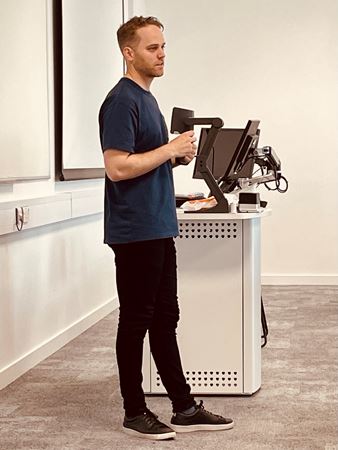US soccer sport scientist shares insight from across the pond
 LJMU graduate and doctoral researcher Patrick Mannix shared his expert insight with School of Sport and Exercise Sciences students as he returned to his educational roots in the city.
LJMU graduate and doctoral researcher Patrick Mannix shared his expert insight with School of Sport and Exercise Sciences students as he returned to his educational roots in the city.
Patrick has spent the past five years working as a sport scientist with US Soccer’s Youth National Team (USYNT) programme, having honed his skills when he studied MSc Sports Physiology at LJMU, graduating in 2013.
He’s now undertaking a Professional Doctorate in Applied Sport and Exercise Science alongside his role supporting upcoming talent in America’s national squads.
During a week-long visit to Liverpool, he spent time with Science and Football, Physiology, and Sport Coaching students, sharing insight into the importance of youth development for a national squad and his applied work preparing players in hot conditions and managing travel fatigue.
He also met with members of LJMU’s Football Exchange and away from campus spent time at both Everton and Liverpool football clubs.
Dr Simon Roberts, Programme Leader Professional Doctorate in Applied Sport and Exercise Sciences, said: “Patrick is an impressive individual and it was great to welcome him back to LJMU. During his time in Liverpool, he shared his experiences of working in elite sport with both our BSc Science and Football and postgraduate students and I am sure they were enriched by his knowledge of the US sporting landscape. It was a busy but productive week and we are looking forward to planning a return visit, this time in Chicago.”
Q&A with Patrick
Tell us about your role with the US Soccer Federation?
My role as a senior sport scientist is to help lead the organisation and delivery of a standardised performance support model for the USYNT programme, which encompasses age categories starting from the under 14s all the way up to the under 20s. I service primarily the under 20 men’s national team, working closely with a large pool of talented young American players based in Europe and North America. A lot of work with both USYNT technical and support staff goes into planning and executing domestic and international camps. Additionally, supporting players’ movement in and out of USYNT camps requires a lot of effective communication with the club’s performance and medical teams.
What advancements have you seen across youth development?
There have been several advancements in youth development in the United States and across North America in general. Significant investments have been made into grassroots, coach education, youth competition programming, and infrastructure. Additionally, investments have been made in the USYNT program at US Soccer, which has allowed the national governing body to support multiple age categories and streamline the pathway into the senior men’s and women’s national teams. All in all, it has been incredibly exciting to witness the growth and development of the sport across the US soccer landscape.
How does your sport scientist role in US national ‘soccer’ differ from that of those working in ‘football’ across the English and European leagues?
The main difference is probably the time spent working directly with players. Typically, I am only on the field with players during FIFA international windows when we host either domestic training camps or attend international tournaments. When not on the road, I am working with our technical and sports medicine staffs to monitor players from afar while they are training and competing with their clubs. We make a huge effort to stay connected with players and provide any supplemental support they may need to aid their individual development. I am also working closely with my colleagues in the high-performance department to ensure standardised sports science services are being delivered across the USYNT programme for both genders.
Can you tell us a little about your doctoral research and how you hope it influences the youth-senior transition in the US and further afield?
My doctoral research aims to evaluate the current state of player development during the youth-to-senior transition in Major League Soccer (MLS). A player’s transition into the first team is one of the most critical periods in their career and may involve moving between multiple environments, including the first team, reserve team, and USYNT. A large percentage of male USYNT players come from MLS clubs, so the better my colleagues and I can understand what the makeup is in the later stages of the US soccer talent pathway, the more we can identify pertinent strategies to support players’ individual development and help elevate overall player development initiatives.
Find out more about the work of the School of Sport and Exercise Sciences at LJMU and the courses available to study.


